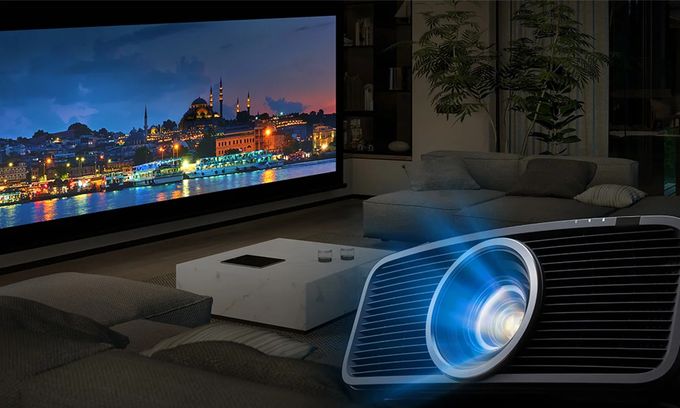As known, contrast affects the sharpness and color saturation, which largely determine the image quality. By type, contrast is divided into native and dynamic.
Traditionally, native contrast is measured in two ways:
– native ANSI contrast.
It measures the whites and blacks of a checkerboard test pattern (eight white and eight black), averages their readings, and calculates the ANSI contrast ratio. The result for DLP and 3LCD projectors usually varies between 200-600:1;
– full On/Off (FOFO) contrast also is calculated as the ratio of white to black, but varies between 500-4,000:1 depending on the technology and model price.
Dynamic contrast uses additional methods, including, for example, Auto IRIS or brightness control, which directly affects the ratio of max white to min black.
Both methods are used with the auto iris turned off. But the ANSI contrast calculation is performed by simultaneously measuring white and black, and FOFO is measured sequentially for each of them.
Native vs dynamic contrast
Given the importance of contrast, companies make great efforts to enhance it. Dynamic iris or auto IRIS or automatic aperture control is one of the main ways. Its increased value is called dynamic contrast. According to the rule of division by ‘0’, the contrast with closed aperture tends to infinity, which is physically absurd. However, this gives companies the formal right to specify monstrously huge dynamic contrast, which is in fact just a marketing tool.
Simply put, a model with high native contrast brightly displays white letters on a black screen. A projector with high dynamic, but low native contrast, displays dim text with gray gradations.
As known, the modern projectors use DPL, 3LCD or LCoS technologies. The JVC dominates the segment of LCoS projectors, which was developed and implemented this technology in 2013. Instead of micromirrors, it uses liquid crystals, the layer of which is applied to a reflective mirror substrate. Depending on polarization, ‘open’ / ‘closed’ crystals reflect or block the light from lower mirrors, modulating the light to create an image.
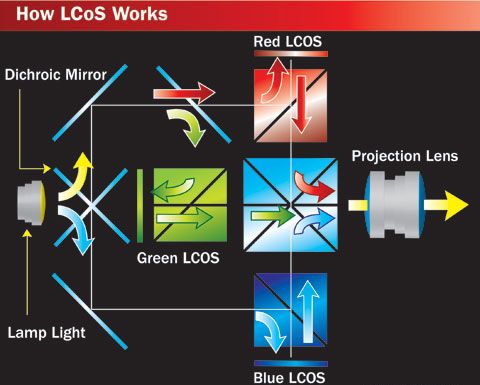
The tiny width of the gaps between the liquid crystals practically does not transmit light in the black zones, providing ‘infinite’ native contrast with ideal blacks.
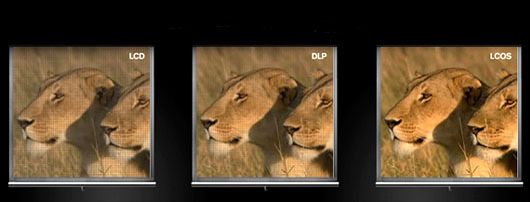
Today companies use several LCoS versions, including JVC D-ILA (Digital Direct-Drive Image Light Amplifier), Sony SXRD (Silicon X-tal Reflective Display) and Canon AISYS (Aspectual Illumination System). Unfortunately, LCoS models are very expensive.
JVC NZ Series
Newest NZ500/RS1200 (~ $ 6,000) and NZ700/RS2200 (~ $ 9,000) JVC D-ILA projectors were announced in September 2024. For reference, formally NZ models are part of JVC’s Procision series, while the RS models are categorized under the Reference series. However, the silver ring encircling their lenses in the NZ models and the gold ring in the custom-install RS models is the only difference between them.
This series also includes the flagship NZ900/RS4200 (~$ 26,000), and NZ800/RS3200 (~$ 16,000), which became available this summer.
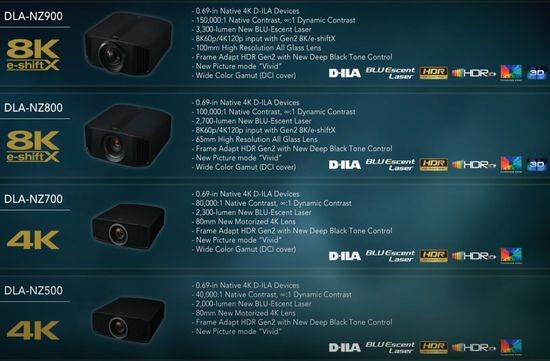
All model have JVC’s 0.69-inch D-ILA (Direct-Drive Image Light Amplification) chipset with native 4K (4,096 x 2,160) resolution. But the NZ500 / NZ700 use its 2nd gen, and the NZ800 / NZ900 have a 3rd gen chipset that supports pixel shift – based e-shiftX technology and can play 8K content. It uses 4-way pixel shifting actuators operating at 240Hz.

In fact, the NZ500/RS1200 is an entry-level projector in the NZ/RS series. The more expensive NZ700 is slightly brighter (2,300 vs 2,000 ANSI lumens, ANSI IT7.228 standard), has twice the contrast ratio (80,000:1 vs 40,000:1) and wider color gamut with Cinema Filter at the expense of a slight decrease in brightness.
The NZ500/700 have become the smallest NZ projectors with native 4K (4,096 x 2,160) resolution (no pixel shift).
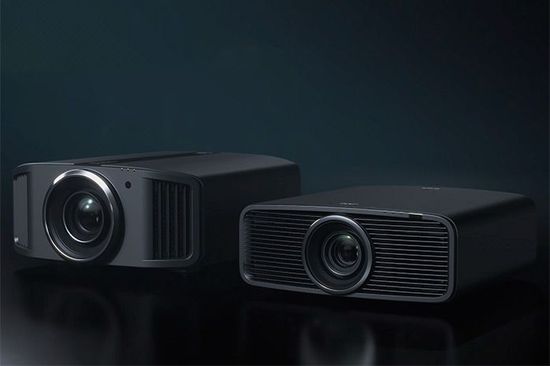
Their dimensions and weight are (18 x 45 x 48 cm)@14.6 kg. For comparison:
– JVC NP5 – (23 x 50 x 50 cm)@19.2 kg;
– NZ800 – (23 x 50 x 50 cm)@23.1 kg;
– NZ900 – (23 x 50 x 71 cm)@25.3 kg.
Unfortunately, NZ500 does not support 4K@120Hz signal. Therefore, its HDMI ports do not have full 48Gbps bandwidth, and operate at 32Gbps with Fixed Rate Link (FRL) of 8Gbps.
Specs & technologies
Despite the series name, the NZ500 may be positioned as an improved laser version of the bulb-based NP5. Their MSRP is the same at $ 5,999, but the NP5 is actually available from some retailers for as little as $ 4,000.
Unlike the NP5, the NZ500 uses a new High Contrast Optical Block with a native contrast ratio of 40,000:1. Basically, testing confirms the stated specs. In an accurate picture mode without laser dimming, the projector demonstrates more than 39,800:1 with the aperture fully closed, and almost 26,800:1 with the aperture fully open.
The light engine with BLU-Escent Laser diode and yellow phosphor wheel also provides the specified brightness. It reaches almost 1,940 ANSI lumens in High Bright mode and drops to 1,650 – 1,750 ANSI lumens in more accurate picture modes.
The NZ500 uses gen2 Frame Adapt HDR dynamic tone mapping, which was first introduced in firmware update 3.0 at CEDIA 2023. As known, its algorithm analyzes the maximum brightness of HDR10 content and adjusts the dynamic range in real time. New improved version optimizes HDR image processing reducing white in the high brightness zone.
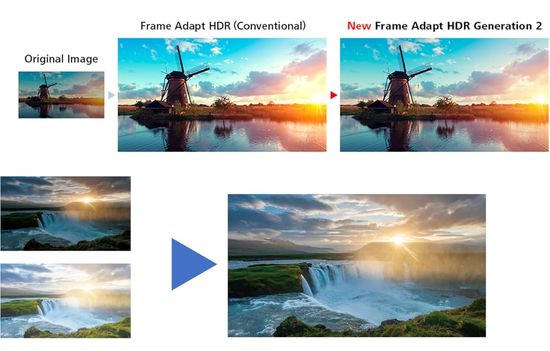
The Frame Adapt HDR can work with new Deep Black function for tone mapping. It uses algorithm to enhance tones in dark frame zones. In fact, Deep Black adds depth without reducing detail in dark gradations.
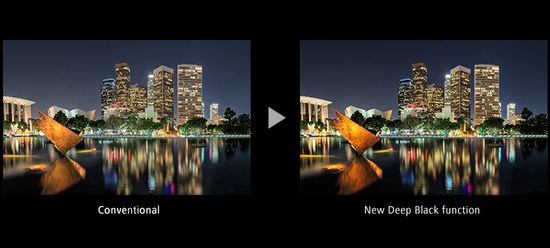
To optimize HDR experience, the projector uses DML (Display Mastering Luminance), adjusting the dynamic range.
The new Vivid picture mode for SDR is mainly intended for animation, CGI (computer-generated imagery) and games. It uses a cooler color temperature and special gamma curve, providing more vibrant images.
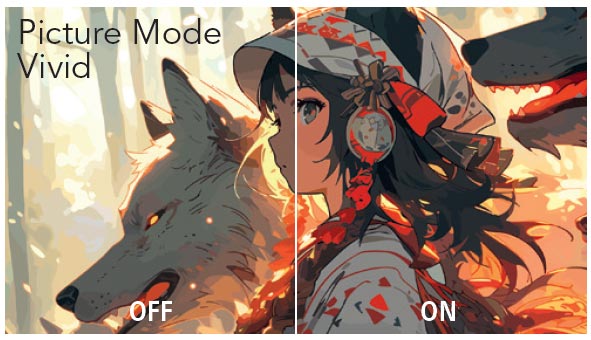
Color modes & calibration
The NZ500’s list of color modes includes Natural, Cinema, Vivid, Filmmaker, and Custom SDR 1 / SDR 2 modes for SDR, and five modes for HDR (Frame Adapt HDR 1 / HDR 2, Filmmaker Mode, Custom HDR 1 / HDR 2). HDR10+ and HLG each use only one picture mode. The list of their settings varies significantly. For example, gamma and color temperature are fixed in Filmmaker Mode.
The calibration capabilities of new projectors traditionally include global adjustments for Contrast, Brightness, Color, and Tint, 2-point RGB white balance controls for Gain and Bias, and a Color Management System (CMS) for adjusting the Hue, Saturation, and Brightness.
To enhance the overall calibration accuracy, the new projectors have JVC Autocal software, which supports adding of reference meter data to the Spyder meters. Due to the difficulty, it’s unlikely to be used by most users who usually choose Auto Calibration. But perfectionists with the necessary equipment and calibration skills will have a blast.
In NZ series the light output is adjusted using the 101-step LD Power control with a scale from ‘0’ to ‘100’. As a result, it provides significantly more precise adjustment compared to the traditional Low, Mid, and High settings. Of course, the fan speed and, accordingly, the cooling performance, depends on the installed power. However, its audible noise level depends little on the mode and is only ~23 dB.
The NZ500 has a new 80-mm, 15-element, 11-group lens with motorized shift, zoom and focus.
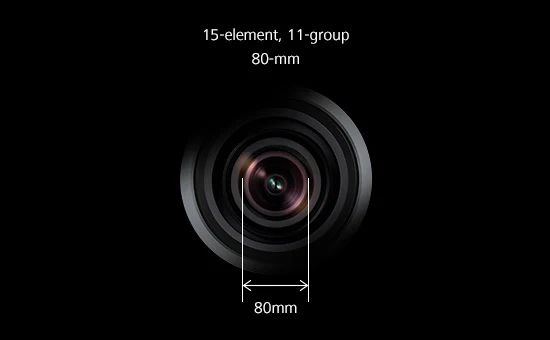
It supports up to 200 inches diagonal image size and vertical keystone.
Conclusion
Pros
– laser phosphor BLU-Escent light engine;
– superb native and ‘infinite’ dynamic contrast;
– Frame Adapt HDR Gen2 dynamic tone mapping;
– ultra precise slider adjustment with 101-step Laser Light Control;
– dynamic tone mapping (DTM) and HDR10+ support;
– 80 mm fully motorized 4K lens with 1.6X zoom, 70% vertical and 28% horizontal shift ranges;
– DML (Display Mastering Luminance);
– new Vivid picture mode;
– ISF Certified & JVC Auto Calibration;
– relatively compact and lightweight.
Cons
– no ALLM (Auto Low Latency Mode) for gaming;
– no 4K@120Hz support;
– Black Frame Insertion only for 60Hz;
– no 3D support;
– no controls on the case.
The renowned Japanese giant has once again confirmed its claim to dominance in the premium Home Theater LCoS projectors segment. Of course, the prices of JVC NZ models remain significantly higher compared to DLP and 3LCD projectors. But the brand’s impeccable reputation, many innovations and radical reduction in size & weight are quite sufficient for cloudless marketing prospects for the new NZ500/NZ700. Therefore, $ 6,000 for the NZ500/RS1200 is already quite acceptable for fans of high quality with a good budget.
In fairness, in the foreseeable future the company may face increased competition from DLP and 3LCD models due to the increase their contrast with AI technologies. Specifically, the AI-based Enhanced Black Level (EBL) feature in the new Valerion VisionMaster projectors boosts the DLP projector’s contrast to an unprecedented 15,000:1. Avoiding the traditional terms (‘Native’ and ‘Dynamic’ contrast), the company vaguely calls it ‘Viewing Contrast’. But regardless of the name, the EBL performance is impressive.
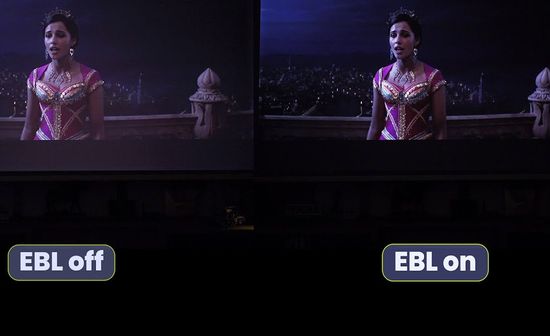
Video presents new 2024 JVC LCoS projectors.
